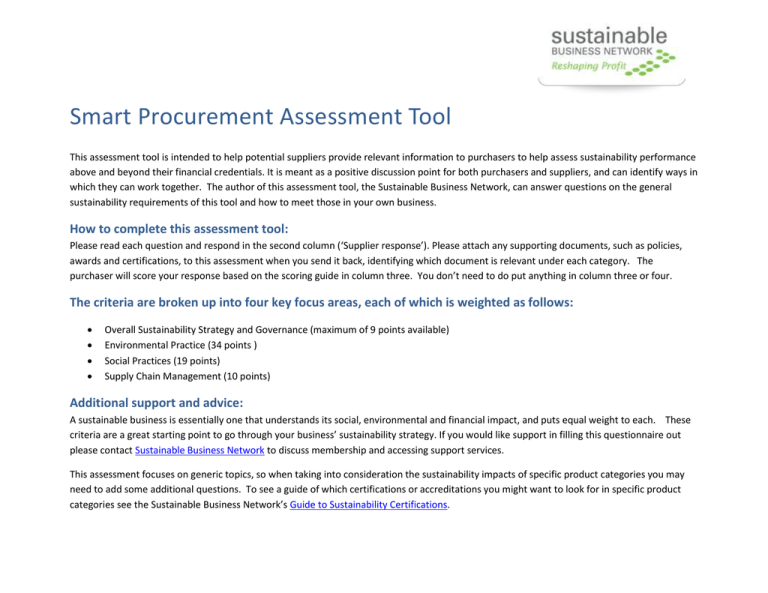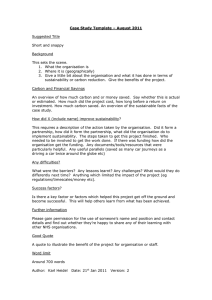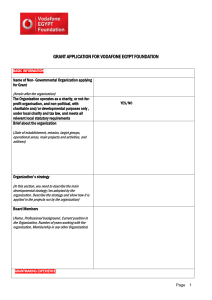How to complete this assessment tool
advertisement

Smart Procurement Assessment Tool This assessment tool is intended to help potential suppliers provide relevant information to purchasers to help assess sustainability performance above and beyond their financial credentials. It is meant as a positive discussion point for both purchasers and suppliers, and can identify ways in which they can work together. The author of this assessment tool, the Sustainable Business Network, can answer questions on the general sustainability requirements of this tool and how to meet those in your own business. How to complete this assessment tool: Please read each question and respond in the second column (‘Supplier response’). Please attach any supporting documents, such as policies, awards and certifications, to this assessment when you send it back, identifying which document is relevant under each category. The purchaser will score your response based on the scoring guide in column three. You don’t need to do put anything in column three or four. The criteria are broken up into four key focus areas, each of which is weighted as follows: Overall Sustainability Strategy and Governance (maximum of 9 points available) Environmental Practice (34 points ) Social Practices (19 points) Supply Chain Management (10 points) Additional support and advice: A sustainable business is essentially one that understands its social, environmental and financial impact, and puts equal weight to each. These criteria are a great starting point to go through your business’ sustainability strategy. If you would like support in filling this questionnaire out please contact Sustainable Business Network to discuss membership and accessing support services. This assessment focuses on generic topics, so when taking into consideration the sustainability impacts of specific product categories you may need to add some additional questions. To see a guide of which certifications or accreditations you might want to look for in specific product categories see the Sustainable Business Network’s Guide to Sustainability Certifications. Criteria Supplier response Scoring guide Score (purchaser completes) Overall Sustainability and Governance: For sustainable benefits to be achieved organisations need a policy Total points mandated by senior management, employees who understand the role they play, processes and systems that deliver and measure sustainability, and targets that are separate to the achievement of only financial profit. 1. Does your organisation have a sustainability policy? 2. How is this policy embedded within your organisation? Guidelines to meet this criteria: Your sustainability policy must: 1. Be signed off by either the CEO, Board or relevant senior management team of your organisation 2. Explain the key material areas for your business, which means the areas of sustainability where your company has the biggest impact, and is of greatest concern to your stakeholders. For guidance on how to work through the material issues for your business see this guide. Depending on what your business does, your key material areas could include: supply and value chain management, environmental management (energy, waste, travel), operating in local communities, and fair employment practices. To create a sustainability strategy see the Sustainable Business Network’s guide here. Please answer the question here: Evidence of this could be: - Sustainability performance is included within all job descriptions and Key Performance Indicators (KPIs). Provide an example of what is put in the job description or KPI - There is an active multi-departmental sustainability group. Provide evidence of who is a member of the group, job titles and when the committee was formed - There are sustainability champions across your organisation. available: 9 Organisation has a sustainability policy but it doesn’t pre-date the request for proposals – 1 Policy meets requirements and includes two of the key material areas for the business as described in point 3 in the explanation box – 2 /4 As above but includes three or more of the key material areas but doesn’t explain why those are material for the business - 3 As above and describes why the business is focusing on these areas in its sustainability policy - 4 Each form of evidence provided receives a point, up to a maximum of 3 points Please provide evidence of who they are - CEO speaks to audiences externally about your organisation’s sustainability journey. Please provide evidence of past engagement, to whom and the topic - Sustainability is recognised as being the responsibility of all employees, and not just one department - Your organisation actively practises demand management with a sustainability focus such as ‘reduce – re-use – recycle’ prior to making new purchases Please answer the question here: 3. Is your organisation’s overall purpose to have a positive social or environmental impact? Evidence required would be your purpose or mission statement which articulates which at-risk community you are serving. If this has already been provided as part of the overall sustainability policy please reference that here. Please answer the question here: /3 The mission statement states that the organisation is operating for a purpose beyond profit /2 Environmental Practices: Environmental management is an ongoing process. In this section we are looking for evidence that you measure, manage, report and ideally verify your critical outputs with an aim to actively reduce the negative environmental impacts caused by your business activity. If you’re a service organisation, this is likely to be focused around your travel and office environment. If you’re a product manufacturer, then your key environmental impacts are most likely to be created through the manufacturing of your products. 4. Managing your environmental impacts: Do you have a system in place that identifies and measures your key impact areas as identified in your sustainability policy above? Please provide evidence of your management system and explanation of how you selected your organisation’s key impacts. This could be an online tool with screen shots which show the organisation name and the areas that you are reporting on (or a link to the system if the information is publically available), or in soft copy form (Excel or Word) with an explanation of how and when the information is inputted. The environmental impact areas that businesses are likely to have include, but are not limited to: - Energy (electricity and gas) - Litres of fuel consumed as a result of operating your business - Waste and recycling Total points available: 34 Evidence provided of how the information is managed – 2 As above plus evidence provided of a management system across all key impact areas with description of why those key areas have been selected – 4 /4 - Water use Please answer the question here: 5. Moving to low carbon business: Are you measuring your carbon emissions (scope 1 and scope 2)? We require you to measure your direct emissions to get points for this question. Please describe, or provide a copy of, your carbon calculations. This could be an online management system, or an Excel document. If you have already supplied this please let us know which part refers to carbon emissions. For guidance and further information how to measure your carbon emissions please see here. To download a free carbon calculator go here. You can also use the following resources for more in-depth guidance: ISO:14064, the Greenhouse Gas protocol and the Ministry for Environment “Guidance for Voluntary Corporate Greenhouse Gas Reporting. Please answer the question here: 6. Reducing: i. Do you have targets and KPIs to reduce the key environmental impacts and carbon emissions identified above in both Q.4 and 5 ii. Do those targets go beyond incremental change? Evidence required here is of targets across the different areas identified above and who is responsible for these targets. This documentation could be in the form of a policy or KPIs for individuals if responsibility is assigned to individuals. See here for examples of these policies. Please answer the question here: Please describe why you chose your targets and how you are changing business processes to meet those targets. Please answer the question here: Data available but for less than six months – 1 Data available for more than six months and up to the past two years – 2 Annual data available for more than two years - 4 /4 Evidence of targets with either environmental management or carbon emissions provided – 2 Evidence of targets with both environmental management or carbon emissions provided (even if there is cross-over) – 3 As above and responsibility for targets are spread across relevant areas of the organisation – 4 Targets require a change in business process to achieve them more than just reduction (i.e. turning off light switches, monitoring /4 water use) – 2 7. Reporting: Do you report (externally and internally) on how you’re tracking against your environmental management or carbon emissions targets? Internal evidence: please provide the most up-to-date report that shows the performance towards targets, associated practices that are enabling you to meet these targets, or, in the case that you are not currently meeting them, what you are doing to change that (whether that be staff education and training, changing suppliers or processes). Every business is different but many face similar challenges when trying to create a transformative organisation. For case studies of businesses that are successfully changing the way that they work see here. External evidence: Link to webpage where the performance for the past 12 months (or the most recent reporting period, which must have finished within the last 12 months) is shared, and/or a PDF of the report and the exact page which shows the performance. Please answer the question here: 8. Verification: i. Do you have any third party verification of your environmental management system reporting? If yes, please supply evidence of a valid and current accreditation. We will accept reports that have been audited to International Certifications: Ecowarranty, ISO14:001, Enviro-mark Silver, Gold, Platinum or Diamond, GRI. Please answer the question here: ii. Please supply a copy of the latest auditor’s report from within the last 12 months which shows your organisation was audited to the standards above. This might include the certifications: ISO14064-1, International Do you have third party verification of your carbon Targets are to create zero impact - 3 Performance is measured and shared internally – 2 /3 As above but also shared externally – 3 Performance is measured and shared (either internally or externally) but organisation hasn’t met the targets identified, however has described what it is doing to achieve these targets - 5 /10 Performance is measured and shared internally, and organisation is meeting targets displayed above – 8 As above plus organisation is externally reporting on targets identified above – 10 Your organisation is accredited to Eco warranty, Enviro-Mark Silver, Gold, Platinum – 2 Your organisation is fully accredited to ISO:14001 or GRI - 4 Auditor’s report provided but more than 12 months old – 1 Auditor’s report provided – 3 /4 footprinting? 9. Have you had any environmental compliance issues or prosecutions in the past three years? Certifications Carbon Warranty (carbon measured, managed or neutral), CEMARS or carboNZero. Please answer the question here: Please cite the case(s) relating to any prosecution(s) you’ve been involved with. Please answer the question here: Auditor’s report provided and scope 3 emissions are included in the reporting- 4 Organisation hasn’t been prosecuted in the past 3 years. Social Practices: All organisations have a responsibility to be a positive influence on the communities they’re operating in. How they do this can take many forms, and we would expect high-performing sustainable companies to be actively considering their staff community, as well as their external communities. Internal Workplace Practices: 10. Do you have policies Acceptable policies are those that go above and beyond health and safety and procedures in standards such as: place to support a - A policy that focuses on pay equality (this may be between the positive and engaged highest and lowest paid employees, living wage, gender, etc.) internal work force? - Policies that support work/life balance such as TOIL (time off in lieu) - Subsidies in place for sustainable lifestyle choices like public transport, active transport, gyms, health insurance etc. - Extended parental leave above and beyond legislative compliance Please answer the question here: 11. Do you have activities and actions to support a healthy workplace? 12. Do you have a diversity and inclusion policy? Evidence would be any programmes or activities that have taken place in the past 12 months that demonstrate positive activities such as: team building challenges, learning and development programmes for all employees, training in sustainability or other life issues (e.g. financial literacy), wellbeing programmes. Please answer the question here: Please provide your diversity policy which is signed off by the CEO, senior management team or Board. For examples of how to write a Diversity Policy see here. Please answer the question here: /4 /1 Total points available: 19 Your organisation has a policy in one of these areas– 1 /4 As above and predates this request for proposals - 2 Policies supplied in two or more of these areas – 3 As above and predates this request for proposals - 4 Organisation demonstrates action in at least one of these areas – 2 Organisation demonstrates action in two or more of these areas – 4 Organisation has a policy that is signed off by the CEO or senior management – 1 /4 As above plus policy includes targets – 2 points 13. Do you actively promote diversity and inclusion in workplace activities? 14. Outside of providing employment, what issues are facing the community you operate in and what are you doing to support these issues? Evidence suggested to achieve this point could be: - Ongoing monitoring of employees’ demographic profile across functions and levels - Providing specific equipment or working areas for those that need it to assist their ability to work. - Educating employees, e.g. on bullying and harassment in the workplace, unconscious bias training - A diversity council/committee/team is in place and is active - Networks to support diverse groups of employees (ethnic, sexuality, gender etc.) are in place and are active - Initiatives are in place to build the pipeline of diverse talent through to senior management positions - Awards from third party organisations in New Zealand for your diversity work with your employees, e.g. the Diversity Awards, the White Camellia Awards or the Pay Equity Awards Please answer the question here: Please provide a policy or description of the issues facing the local community you operate in that are relevant to your business and how you are addressing these issues (this might be site location, key markets that you serve or your supply chain, wherever the need is greatest). Examples could be: - Staff volunteering doing unskilled work (i.e. beach clean-ups) - Skilled volunteering (pro bono) to relevant community groups - Strategic partnerships with community organisations - Providing resources (e.g. office space, products) to community groups - Awards that have been won for community investment initiatives - Donations to not for profit groups - Specific products or preferential pricing schemes that make your products and services accessible to at risk communities To see examples of what other companies are doing see here. Please answer the question here: /2 Evidence provided of actions or activities that have contributed to good diversity outcomes – 1 point per evidence provided to a maximum of 2 points Organisation has won an award for diversity in New Zealand in the past two years – 1 point available /3 Organisation has identified a socio-economic issue for its business and has demonstrated at least one thing it is doing to support this- 2 Additional points are available for where the business can demonstrate the different activities it is involved with, with a maximum of 4 additional points available. /6 Supply Chain Management: What do you do to incentivise sustainability within your own value chain? Total points available: 10 15. Do you have a policy (either stand alone or included in a broader sustainability policy) which outlines your approach to sustainability in your value chain? 16. Do you have a system to assess your suppliers based on their sustainability performance? 17. Is this policy or tool included in all tenders? To meet these criteria your sustainable supply chain management policy must predate the date of request for proposals and be signed off by either the CEO, Board or senior manager of the organisation. Note: If you have previously provided this you don’t need to provide it again. Please answer the question here: Organisation has a policy – 1 Please supply evidence of a system or tool. You can use this assessment tool if you don’t already have a system or tool in place. Please answer the question here: Organisation has an assessment system – 4 Please supply evidence of this, which could be a tender or supplier contract that predates this request for proposal. Please answer the question here: Evidence supplied that this has been used in more than one tender 18. Do you reward your suppliers for sustainable innovation? Please supply evidence of the process or mechanism and/or achievement data that shows how innovation was rewarded for the supplier. Please answer the question here: Evidence supplied The policy predates this request for proposals and complies with all other requirements - 2 /2 /4 Contributors: This guide has been created by the Sustainable Business Network with the support of some of its members. The Sustainable Business Network would like to thank specifically Michael Field (Waitemata District Health Board), David Nellist (IAG), Michaela Bennett (NZ Post) and Andrew Walters (Auckland Council) for their in-depth help in developing this guide. Other contributing organisations include: Auckland Council, AUT University, Bank of New Zealand (BNZ), Chorus NZ Ltd, EEO Trust, Fuji-Xerox, Fulton Hogan, Hutt City Council, NZ Post, NZI, Opus International, Resene Paints Ltd, Ricoh New Zealand Limited, Staples, Tourism Holdings Ltd, Toyota , Unitec, Vector Limited, Victoria University of Wellington, Waitemata DHB, Wellington City Council, Wellington Zoo Trust, Westpac, Z Energy /2 /2







